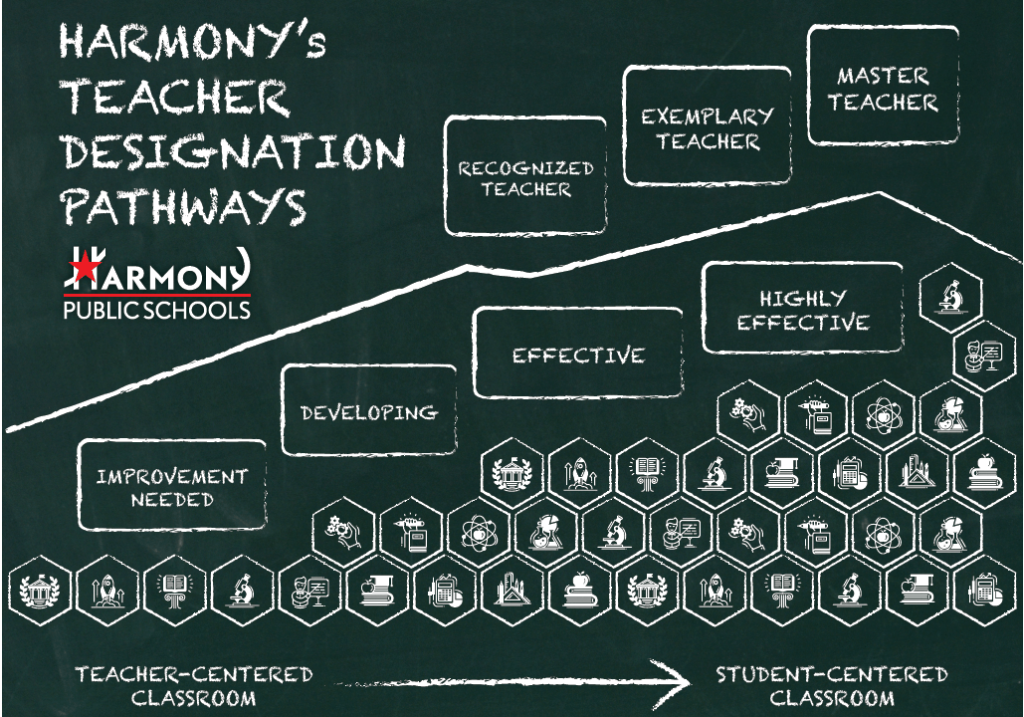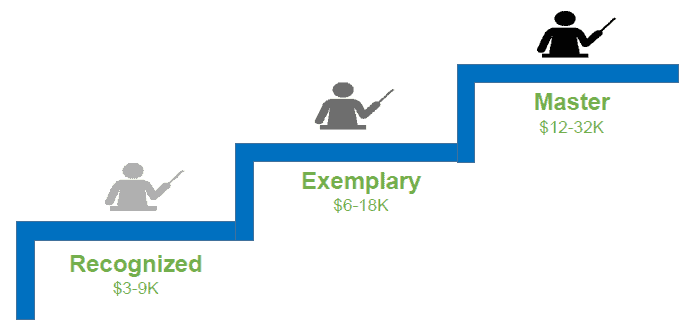Change Management at Harmony Public Schools: When Prior Innovations Become Status Quo

By: Burak Yilmaz
One of the reasons I enjoy working at Harmony Public Schools so much is the fact that a culture of innovation is rooted in this dynamic network. The only thing constant at Harmony is change itself.
At Harmony, we take innovation and change management so seriously we won’t start something significant unless there is a well thought out strategic planning process that clearly shows all the necessary steps with design, rollout, implementation support, evaluation, and most importantly, sustainability. That is why most of our biggest innovations start with a carefully written competitive grant proposal, which not only helps with having a solid 5+ year plan but also provides the necessary seed funding to get off to a strong start.
How We Started
The Race to the Top District Grant has been a great program for Harmony to create student-centered and personalized learning environments across the network powered by a flexible blended learning model and a unique approach to project-based learning (PBL). This massive investment in designing a tech-powered, unique learning experience for students revealed other gaps over time that we needed to invest in just as vigorously. Namely, a similar personalized professional learning for our educators. If learning is personalized for children, why should it be any different for adults? This gave birth to a new idea, and our next attempt at another big grant. It was time to rethink professional learning, and the Teacher Incentive Fund was a great opportunity for us to do just that.
When drafting a proposal for Teacher Incentive Fund, Harmony leaders thought about several challenges the organization faced with professional learning. Our conversation was driven by these key questions:
- How can we see application of PD in our classrooms at scale? (moving from theory to action)
- How do we align PD to educator evaluation and student outcomes more clearly?
- What can we do to support teachers with their career aspirations?
- How do we approach placement of effective educators into leadership roles and ensure their success in those new roles?
We were confident that if we could come up with innovative solutions to tackle these issues, we would achieve the ultimate goal of retaining our top talent and Harmony Public Schools would be an organization where all educators with a growth mindset could thrive. The more we thought about changing educator practices, connecting PD to student outcomes, making PD more job-embedded and personalized, and integrating professional learning into career pathways, the more inspired we’ve become as a team to dream bigger for our students and teachers. We landed on microcredentials as the means to accomplish this.
Developing From Within, Promoting From Within
Since the inception of our charter network, Harmony has been obsessed with developing home grown talent—especially for school and district leadership positions. Microcredentials gave us the idea of creating a badging system where promising educators could slowly but surely build their competencies to prepare themselves for a leadership role for which they aspire. The idea of defining excellence for each role within the organization and then identifying core competencies needed for success in those roles created the much needed clarity and transparency for career pathways and understanding how one can move up within the organization.
Through microcredentials, the competency-based approach to professional learning connected to career pathways has been a game changer for Harmony. Before microcredentials, when we needed an educator to serve in a leadership role—in or out of the classroom—we would naturally select someone with a strong record of success in the classroom. However, in the absence of a role-aligned PD and support system, many of these talented educators would underperform and feel frustrated, which often led to increased attrition. These leadership roles require a completely different set of skills that needed to be built over time.
Microcredentials helped us build those pathways and now educators are able to see what is available to them to advance their careers and more importantly they have a clear path ahead and a professional learning plan to get there, whatever their career aspirations may be.
Though exciting and promising in theory, it was not easy to create excitement and buy-in from frontline educators. Microcredentials are still a relatively new development in our field and it requires a significant mindshift for teachers and school leaders to leave behind traditional practices and embrace this new outcomes-based approach. This calls for educators to get out of their comfort zones and allow themselves to be vulnerable during the process. To overcome these implementation challenges, Harmony decided to do four things very carefully and strategically:
- Vision: This big culture shift requires a clear vision and alignment from key stakeholders within the organization. Educators need to understand why this is important, where it fits in the bigger picture, and how this will impact them.
- Incentives: Without meaningful incentives, it is never easy to engage people and create a good momentum. Harmony created both short term incentives that award stipends for earned microcredentials and also long term incentives that unlock career advancement opportunities in the future.
- Phases: Change at this scale takes a long time until it becomes part of the culture. It is important to design a phased approach and start with a manageable pilot rather than trying to boil the ocean. Rolling out microcredentials in phases also allowed Harmony to see opportunities and challenges before expanding the program and implementing at scale.
- Supports: This is probably the most critical and hardest part. Educators will need lots of support especially in the beginning until microcredentials become fully integrated into the organization’s professional learning culture. Adjusting to the new way of learning and navigating through uncharted waters will require a lot of mentoring, coaching, and other forms of support even for some of your talented veteran teachers.
Putting It All Together
Most educators need a clear pathway for career advancement and a means for making incremental progress to get closer to their aspirations. Other districts may be invested in microcredentials but only for professional learning. Harmony has been intentional from the beginning, linking all microcredentials to leadership roles within the career pathways, in or out of the classroom.
In order to make this work, organizational readiness is critical. There are many elements of the larger human capital management system (HCMS) often operating in silos in networks and organizations. Harmony was no exception to that. We had many silos operating independently such as educator evaluation, professional development systems, career advancement, licensure requirements, and pay-based incentives. The lack of clear alignment across these various elements resulted in staff frustration and confusion, higher attrition, and cost inefficiencies.
Microcredentials gave us an opportunity to create a universal alignment of these HCMS elements to career pathways, which helped the organization achieve critical outcomes such as clarity of vision, significant cost savings, higher employee retention, and more time spent on what matters most: improving outcomes for kids.
Sustainability
The Teacher Incentive Fund provided Harmony a great opportunity for establishing a robust teacher evaluation and support system, creating competency-based career pathways via microcredentials, and, most importantly, designing a performance-based compensation system (PBCS). The historic House Bill 3 in Texas provided many exciting opportunities and additional funding for public school districts in the state. One of them is the Teacher Incentive Allotment (TIA). Through this allotment, districts in Texas are able to create a local teacher designation system and award Recognized, Exemplary, and Master designations based on classroom observation scores and student growth measures. And there are significant pay increases for these designated teachers, up to $32K, all compensated by the state with no additional cost to districts.

However, according to this bill, districts can only apply for the Teacher Incentive Allotment after they have designed a performance based compensation system and have already paid incentives to their high performing teachers at least once. Harmony Public Schools had the required system in place and have been awarding performance pay for the past 5 years. This presented a golden opportunity for Harmony to sustain its efforts around career pathways and performance-based compensation. In addition to teacher observations and student growth measures, Harmony added a teacher portfolio component to its local designation system, which is driven by microcredential attainment. With our TIF grant winding down, the rollout of TIA designations gave microcredentials more leverage for our organization and a tremendous motivation for our effective teachers to invest in their portfolios and make themselves eligible for a designation. TIA is not only helping Harmony with the sustainability of its HCMS, but also strengthening our core message to our most effective educators. Now, leaving the classroom is not the only option for moving up the career and compensation ladder. As the commissioner of education in Texas says, TIA will give Texas teachers a realistic path to a six-figure salary.
What Is next?
Now, as we are focused upon the Teacher and School Leader (TSL) grant from the US Department of Education, Harmony’s goal is to create performance metrics informed by a “skills profile” for each educator, and similarly develop a “needs profile” for each campus based on school performance and characteristics. The educator skills profile will be powered by microcredentials and will be used for setting up an educator-school match system running on a smart algorithm to recommend matches based on these profiles. This will allow us to place our best talent in the highest need schools where the skills and needs fit together like a jigsaw.
This is a work in progress for the near future at Harmony and is a prime example of how artificial intelligence can transform human capital in building capacities in our educators and maximize their performance.
Additional Resources:
- Microcredentials: A New Currency for Educator Advancement
- Developing a student-centered workforce through micro-credentials
- Teacher Incentive allotment: Rewarding Teacher Excellence in Texas
For more, see:
- Harmony’s Commitment to Microcredentials: A Close Look at their Professional Learning Experience
- Meet the Culture Hackers: Microcredentials Aren’t Just for Students
- Back to School with Harmony
This post is part four of a five blog series in the upcoming “Getting Smart on Competency-Based Career Advancement at Harmony Public Schools” produced in partnership with Harmony Public Schools (@HarmonyEdu).
Burak Yilmaz, Ed.D., is the Director of Instruction at Harmony Public Schools.
Stay in-the-know with innovations in learning by signing up for the weekly Smart Update.




0 Comments
Leave a Comment
Your email address will not be published. All fields are required.